Buildings & Energy
The Perth and Kinross Climate Action Plan provides our overall vision to ensure we achieve a low carbon and climate resilient Perth and Kinross. The plan identifies Energy and Buildings as a key area where we will have to make changes in order to tackle and adapt to climate change. The combined domestic (homes) and non-domestic buildings emissions made up 34% of total emissions in Perth and Kinross in 2019.
Across all of Perth and Kinross, the total emissions from domestic buildings is 266 ktCO2 and non-domestic including public sector and commercial uses is 104 ktCO2, of which 16 ktCO2 is from Perth & Kinross Council's own estate. This is mainly from space and water heating, as well as the equipment we use to light and power our homes and businesses.
The ambitious and challenging Scottish Government targets for both the domestic and non-domestic sector are detailed within our road map below.
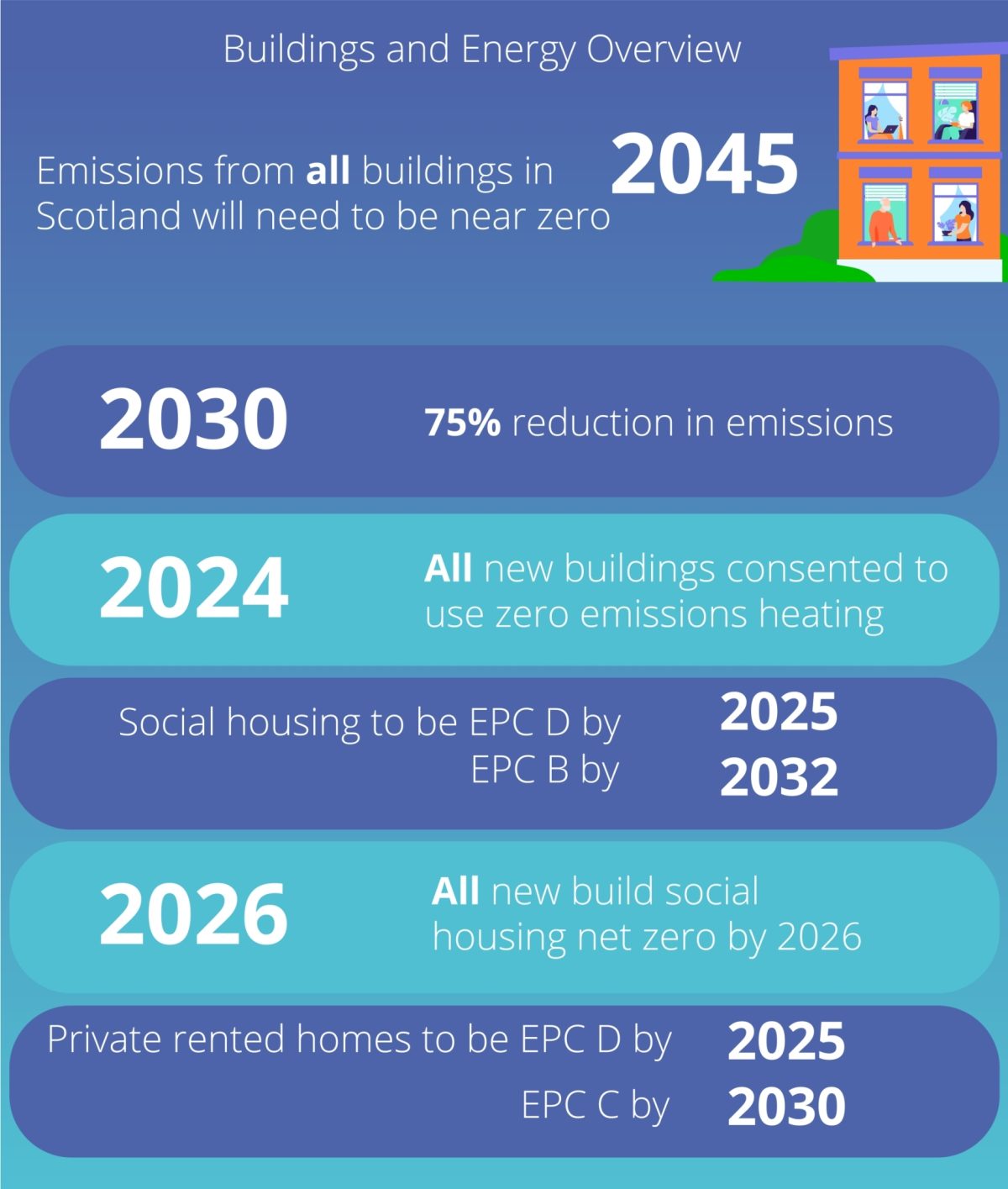
Key themes
To decarbonise its estate Perth & Kinross Council are undertaking several measures including improved building management systems, use of renewable technologies to provide heating, hot water, and energy generation. This is just the start of the journey to Net Zero and Perth & Kinross Council will be installing more of these systems and adopt a ‘fabric first approach’ as part of its Capital improvement and investment programme.
Emissions from Buildings and Energy have been steadily decreasing across Perth and Kinross and dropped by 45% between 2005 and 2019. The majority of this saving has been due to improved energy efficiency and the transition of the electricity network from dirtier to more renewable energy sources.
To help set the foundation for further decarbonisation, Perth & Kinross Council has undertaken an Area wide assessment across the whole of Perth and Kinross to include the investigation of future local heat and energy efficiency strategies.
Perth & Kinross Council is developing partnership working with other public sector bodies to achieve Net Zero targets. An example of this being the recently completed project with Police Scotland at Crieff area offices.
As a large service with over 7,760 council properties and over 300 staff, Perth & Kinross Council's Housing Service recognises the impact our business activities can have on the environment. As a responsible service we can take significant steps to reduce the carbon footprint of our services, and of our staff, tenants and residents.
As a service, our commitment to helping tackle climate change will be embedded in everything we do. The housing service's Offer on climate change sets out our commitments to ensure we can fulfil our aim in respecting and protecting the environment.
The Housing Service's Climate Change Offer
Tenants and residents - We will:
- Engage with tenants and residents to provide information for them to gain a greater understanding of climate change, to help encourage positive behaviour change.
- Provide support and assistance to our tenants and residents to help influence their behaviour and individual choices, with the aim of reducing fuel poverty and minimising the climate impact.
- Support our local communities through environmental initiatives and projects to improve neighbourhoods.
Council properties - We will:
- Undertake a detailed assessment of all our council homes to ensure that our tenants and residents can live in warm, dry, energy efficient and low carbon homes which they can afford to heat.
- Ensure our new build housing meets the relevant housing standards and energy efficiency requirements.
- Aim to ensure that through our capital programme, energy efficiency options are prioritised when replacing windows, doors and heating systems to help us achieve our aim of low carbon homes.
- Ensure our plans for new housing and improvement works includes renewable energy products and the use of smart technology.
Our staff - We will:
- Provide staff with the information, skills and training to gain a greater understanding of climate change.
- Engage with staff to encourage positive behaviour change to reduce climate impact through influencing individual choices - colleagues, tenants and residents.
- Ensure our staff embed this awareness and training within their role, and how they support and work with tenants and local communities.
Working with our community partners - We will:
- Work proactively with a variety of teams and services to help our staff, tenants and residents access the appropriate support, guidance and funding.
- Work with Private Landlords to help improve housing conditions and energy efficiency measures within the private sector.
- Ensure when tendering for projects or working with external contractors our commitment towards respecting and protecting the environment is included within our agreements.
- Deliver on the actions set out within the Council's Climate Emergency Action Plan.
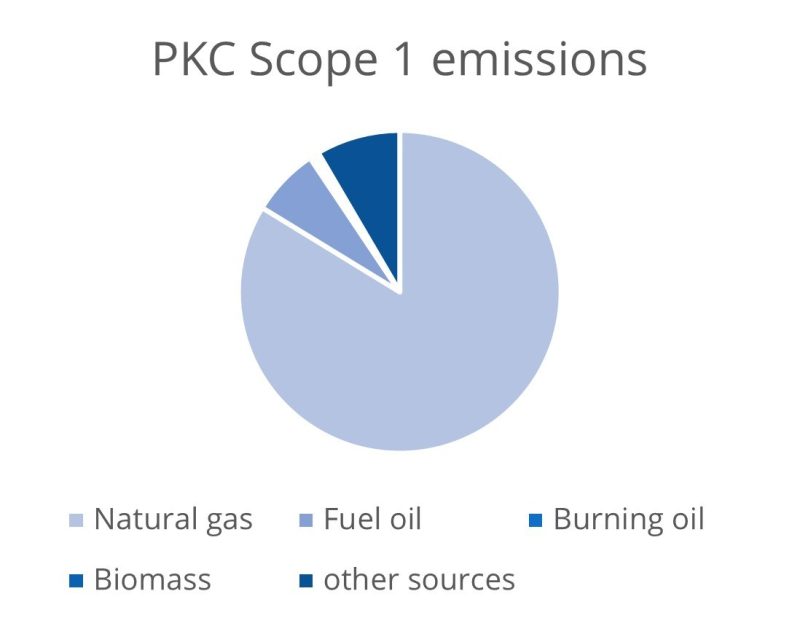 | Energy is a large contributor to Perth & Kinross Council's Scope 1 emissions as it is responsible for 76% of emissions. The biggest amount of this comes from natural gas which is mainly used to heat buildings and water. |
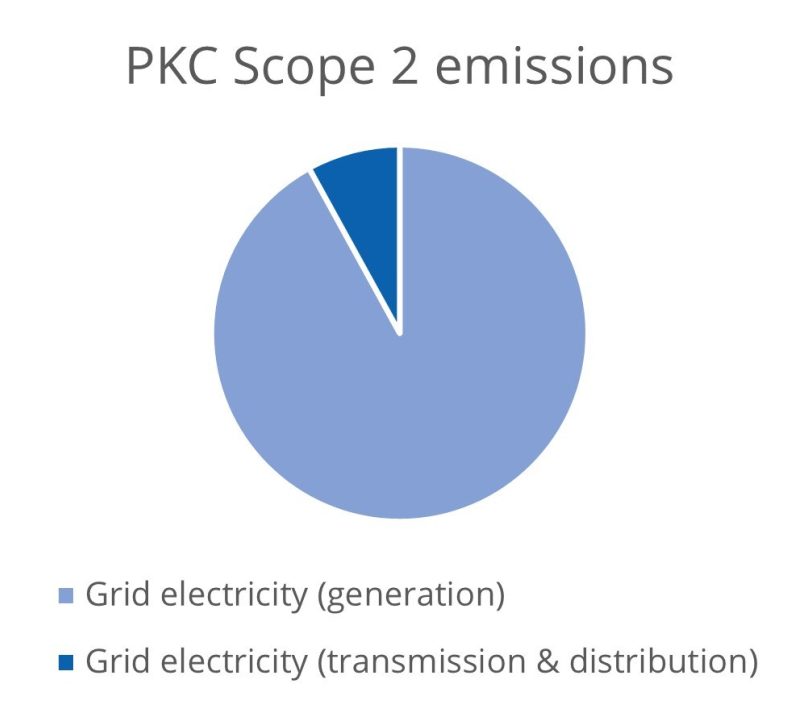 | The energy sector and more specifically energy from generating, transmitting, and distributing grid electricity is responsible for Perth & Kinross Council's Scope 2 emissions |
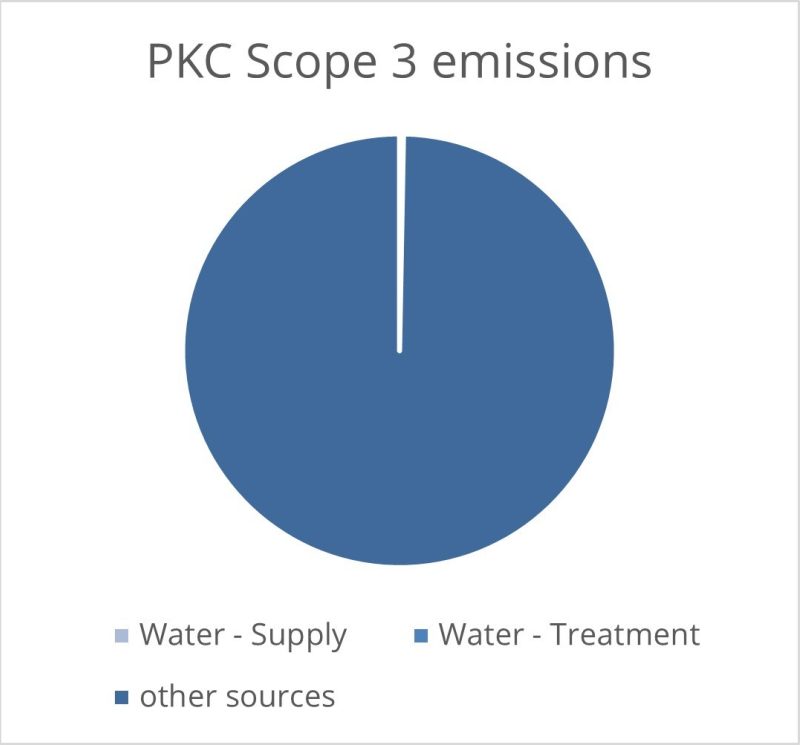 | Energy only contributes a very small amount to Perth & Kinross Council's Scope 3 emissions as 99.75% of these emissions comes from other sources, mainly waste. |
Perth & Kinross Council has a requirement to meet the challenging net zero targets set by the Scottish Government. To determine the full extent of the requirements, it will be necessary for
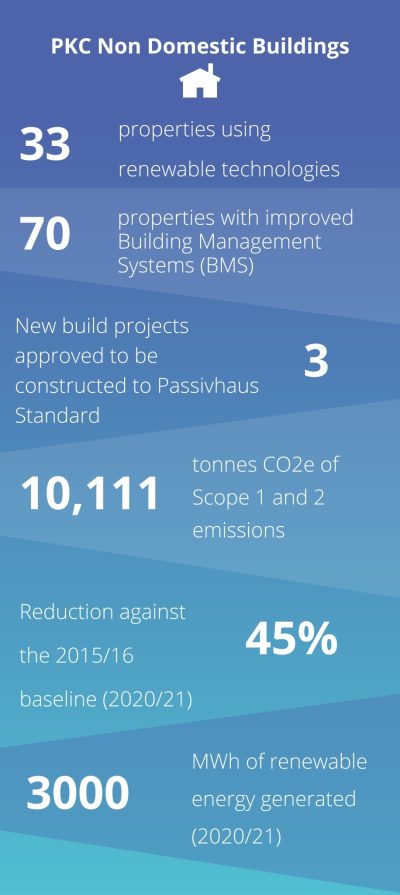
Perth & Kinross Council to review and assess the estate portfolio to develop options, costs, and funding avenues for all Perth & Kinross Council buildings to be Net Zero by 2045. The options will include using low and zero carbon construction methods such as Passivhaus for all new build and refurbishment projects. There is an expectation that any measures undertaken should reduce heat demand, decarbonise heat and adopt a ‘fabric first’ approach improve energy efficiency. All of which align with the Scottish Government's draft Heat in Buildings strategy, proposed changes to the Scottish Building Standards and the Scottish Futures trust (SFT) Net Zero Public Building Standard.
- Ahead of the full review of the Perth & Kinross Council estate portfolio, a ten-year programme of quick wins across the non- domestic estate has been developed focused on off-gas grid properties, improving energy efficiency, and increasing solar potential. Following a more detailed review of the energy efficiency works required for the non-domestic estate planned for 2022-23, this programme will need to be significantly expanded to meet the public sector targets.
- Actions also aim to reduce emissions through a combination of maximising and optimising the use of the Perth & Kinross Council estate, reducing energy consumption whilst carefully considering our Corporate Asset Management strategy and smarter working review. It is important to champion behavioural change at all levels throughout the organisation to consider how we use our buildings better to achieve the required targets. Expenditure programmes should also align across services with an emphasis on the projects which are shown to provide the greatest reduction in greenhouse gas emissions.
Actions include developing partnership working with other public sector bodies and community planning partners to achieve Net Zero within Perth and Kinross by 2045. This will involve working collaboratively to share buildings and resources to meet these targets. An example of this being the recently completed project with Police Scotland at Crieff area offices.
- It is important to continue to work together across the whole of Perth and Kinross to carry out an area wide assessment including the investigation of future local heat and energy efficiency strategies, using district heating networks where viable. This assessment would include existing energy resource demand for heat and transport; energy storage potential; building stock (domestic and non-domestic) and would provide the foundation for future work.
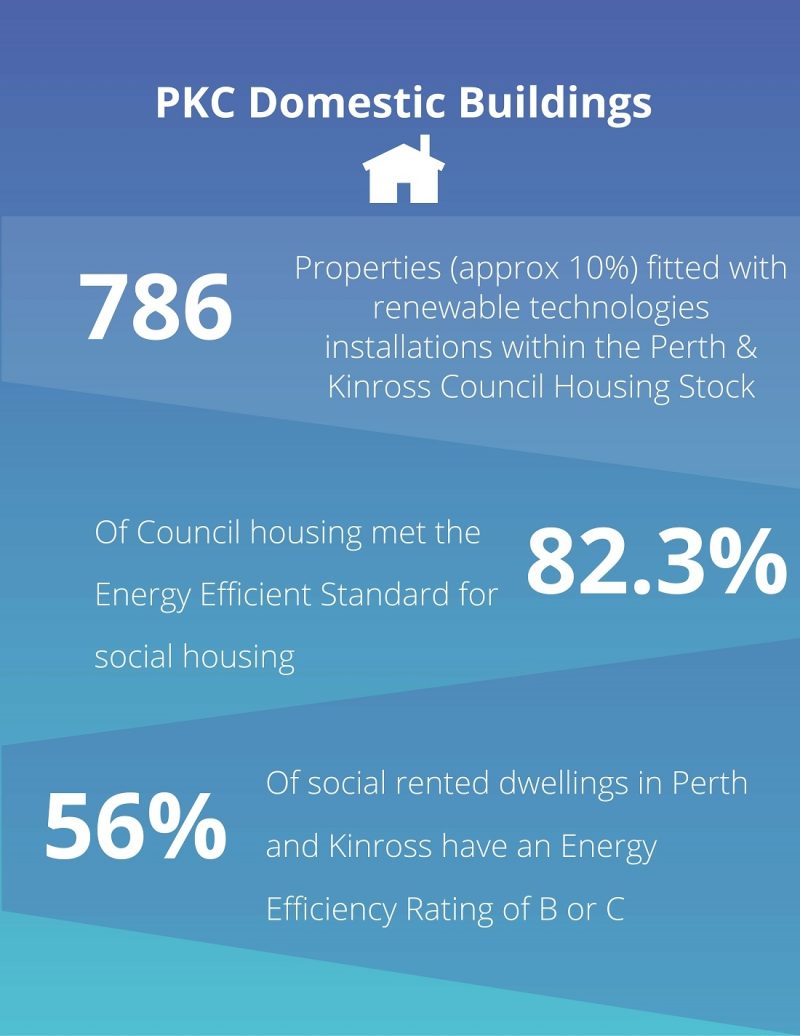
One of the policy drivers is the need to construct all Perth & Kinross Council New Build homes to meet a minimum EPC B and to be net zero by 2026. Developing an updated Design Guide, to provide clear guidance on our specification requirements is an important first step. We plan to investigate options and costs for Low and Zero Carbon construction methods, including Passivhaus, through delivery of exemplar projects where the ‘fabric first’ approach and measuring energy efficiency will be key considerations.
- We will review and assess our existing Perth & Kinross Council housing stock (approximately 7,800 homes) to develop a programme of measures that will improve their energy efficiency up to a level of EPC B by 2032. As part of this, we may have to consider the retrofitting of properties and options for this will be investigated
- Ways of supporting and encouraging our tenants to reduce the carbon footprint of their homes through behavioural change are also necessary, as this has the potential impact of reducing carbon emissions by up to 50%. Developing tenant knowledge and the means to use technology effectively is also key. Fuel poverty and income maximisation also need to be considered, to ensure that the impact on tenants is lessened. Opportunities for tying into heat networks will also be investigated.
- There has been limited progress on installing other energy efficiency measures more recently as a result of Covid restrictions; we have recommenced the installation of Internal Wall Insulation in a small number of properties as part of our energy efficiency programme of works. The External Wall Insulation programme is likely to recommence in the new financial year.
To align with the requirements for Perth & Kinross Council New Build properties, all new affordable housing within the Perth and Kinross area will need to meet the requirements set out in our updated Design Guide and we will work with local Housing Associations (housing stock of approximately 4,000 homes) to maximise the number of social rented homes achieving EPC B by 2032.
- Work is also needed to raise the awareness of landlords in the private rented sector (approximately 12,000 homes) of the requirements they need to meet, and we need to find ways of directing them to technical advice with the aim of supporting them to upgrade their properties; this will include addressing the challenges of carrying out works to multi-ownership blocks.
- Where possible, we also need to assist private owners to prepare for the deadlines for the private housing sector (approximately 45,000 homes in Perth and Kinross). We should lead by example and will need to commission research into fuel poverty in the private housing sector so that we can quantify and understand some of the challenges that are being faced across this area of the housing sector within Perth and Kinross.
- One of the significant pieces of feedback received through public engagement is that residents want and need a place for trusted advice. Our Home Energy Advice services currently reach a few hundred households per year. Whilst Perth & Kinross Council does not have a statutory duty to provide an advice service, to reach overall climate change targets, we need to support homeowners to meet their EPC obligations. One potential option is the provision of local and trusted one-stop shops for energy efficient advice. An example of this is the successful HEAT pilot project in Blairgowrie. We also need to ensure that the same level of trusted advice is available to our business community particularly small businesses.
As part of Perth & Kinross Council's response to mitigate the impact of Climate change, there are also several measures that we will undertake which combine both non- domestic and domestic buildings. These initiatives include supporting the development of the Perth Smart Energy Network to store and trade energy between buildings to utilise demand management and reduce energy consumption. An important action is also to engage with SSEN to ensure that there is appropriate grid capacity available to feed in new renewable sources. This will be necessary to explore the potential for local energy generation, EV charging infrastructure and decarbonising heat for all buildings
- We will also develop heat networks, where viable, in line with Local and National Energy Efficiency targets. Local Heat & Energy Efficiency Strategies (LHEES) are a key component of the Scottish Government’s strategy for all buildings meeting net zero targets, and all local authorities will be required to prepare these short-to-long term strategies to reduce emissions from buildings and tackle fuel poverty. This will be by identifying coordinated actions for all domestic and non-domestic buildings tailored to the local area, as well as identifying zones suitable for the development of heat networks such as the district heating proposals being considered for the Thimblerow area of Perth. LHEES will have a vital role in planning our long-term approach to decarbonising the heat supply.
A climate emergency has been declared internationally and recognised by both the UK and Scottish Governments. The key long-term target is to ensure Perth and Kinross is Net Zero by 2045 at the latest. To achieve this, the majority of action required must be underway by 2030. The following road map provides an overview of the actions which Perth & Kinross Council will undertake to achieve these targets in relation to buildings and energy.
On a strategic level, there will be a requirement on Local Authorities to produce a Local Heat and Energy Efficiency Strategy (LHEES) by 2024. Associated with this wider strategy, the Heat Network Act (2021) enabled local authorities to become responsible for awarding heat network consents and for the designation of heat network zones.
There are several legislative and policy targets, applying to both Perth & Kinross Council's own estate as well as to the wider Perth and Kinross area. These include:
Domestic:
- From 2026 social housing must be a minimum of EPC D and, from 2032, a minimum of EPC B to be re-let.
- From 2025, for properties to be re-let, they need to be a minimum of EPC C if technically feasible - with all properties upgraded by 2028.
- From 2040 all owner-occupier properties to be a minimum of EPC C by 2040.
Non-domestic:
- By 2030 achieve a 75% emissions reduction from public sector buildings
- By 2038 all public sector buildings to have zero emissions heat
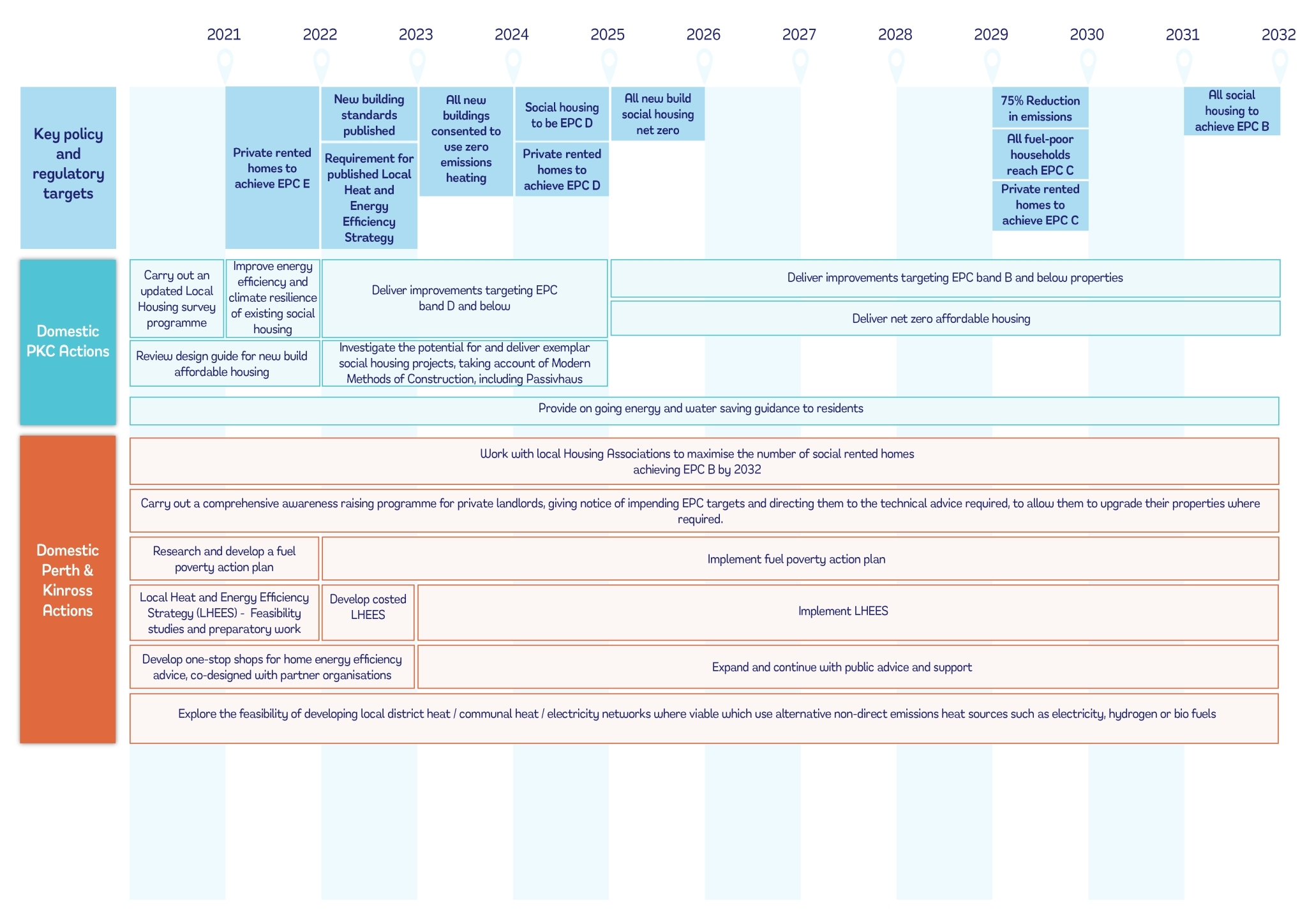
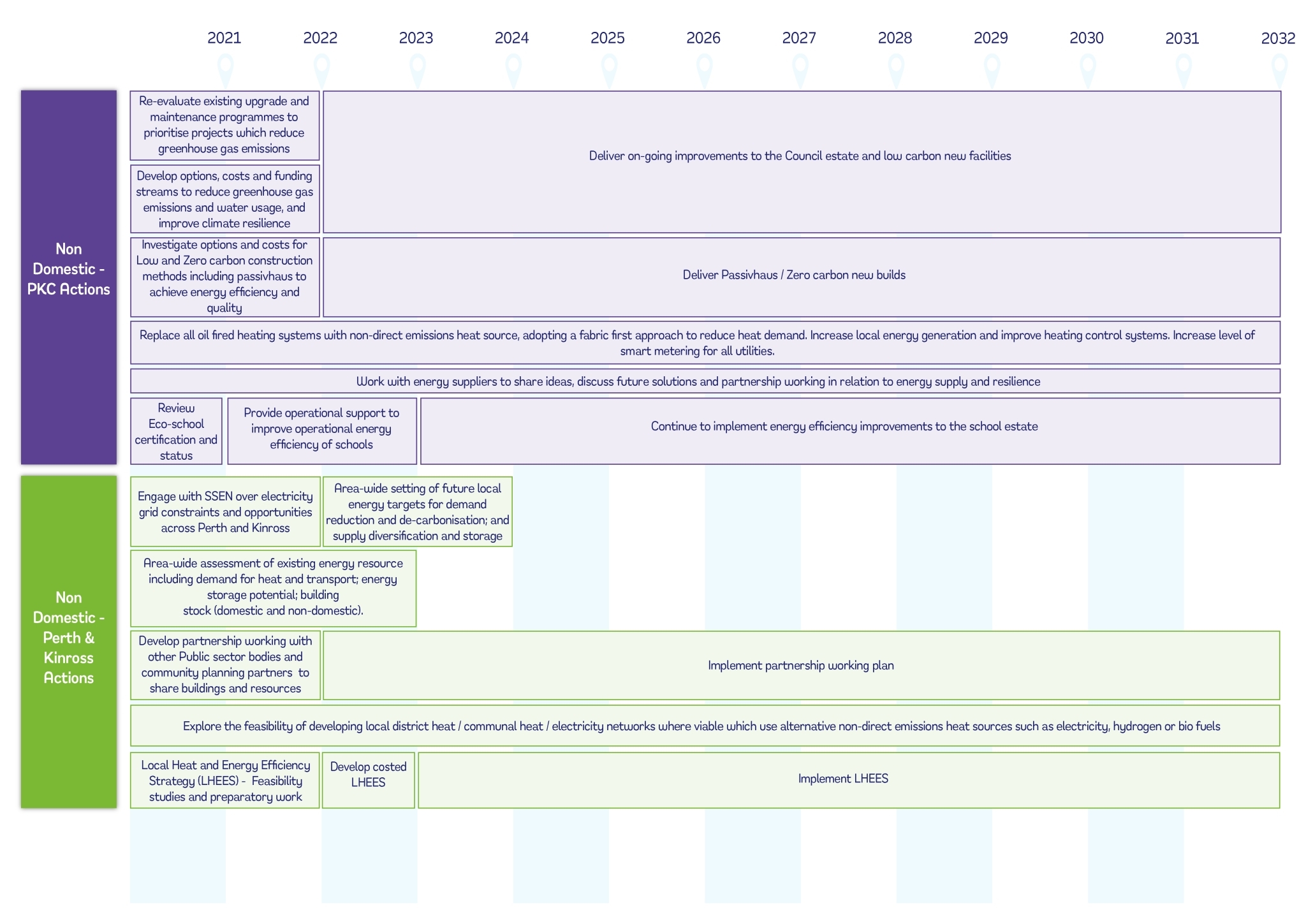
The following key challenges and opportunities have been identified and assessed during the development of our Climate Action Plan. We have implemented a strategic plan to reduce or eliminate the possible impacts of challenges and we are focussing on potential opportunities, implementation, and outcomes.
National Action & Local Leadership
Locally we need to actively engage in consultations as national policy and legislative drivers are in development. In addition, we aim to deliver all Perth & Kinross Council led consultation via our Climate Consultation Hub.
Engagement, Culture & Inclusion
It has been recognised there is a need for significant behavioural change within our Local Authority, communities, and businesses with an emphasis on increasing climate literacy relating to buildings and energy. This is essential to ensure we can collectively make positive change and minimise our human impact on the environment, whilst ensuring issues such as Fuel Poverty are considered.
Skills & Capacity
Appropriate skills are necessary to undertake the climate agenda. Perth & Kinross Council are leading the way by investing in current staff and providing them with training to have the relevant skills required to tackle climate change. In addition, we will be working closely with our external partners to provide career pathways and encourage investment in staff through Community Benefits and partnering arrangements.
Infrastructure & Innovation
The examples below highlight the importance of innovative solutions which support businesses with new business models. These solutions are essential to overcoming barriers.
Example 1:
Improving the Building Management Systems (BMS) to extend this to all non-domestic buildings within the Perth & Kinross Council estate. This can be replicated by other organisations and provides the data to be able to analyse and control electrical, heating and ventilation systems within buildings to reduce energy consumption and greenhouse gas emissions.
Example 2:
Develop options, costs, and funding avenues for Perth & Kinross Council Estate Portfolios to reduce greenhouse gas emissions. Options should include non-direct emissions heat source and Low and Zero carbon construction methods such as Passivhaus/Enerphit for all new build and major refurbishment projects to achieve energy efficiency and quality. These measures could be replicated by removing barriers and sharing innovative ideas and solutions with other organisations throughout the Perth and Kinross area.
Example 3:
Installation of Building Management Systems (BMS) on communal heating systems within sheltered housing complexes is being progressed; this should allow remote monitoring and adjustment of the systems to analyse and control the heating in a more efficient way.
Example 4:
In initial stages of considering proposals as part of the Perth & Kinross Council Smart Energy Networks project to explore scope for an energy project in Rattray working in partnership with Power Circle Projects Ltd and The Heat Project (part of Blairgowrie and Rattray Development Trust). The project concept is for a smart local energy system serving Rattray with a mix of onsite and local low carbon electricity generation and storage, low carbon heat, smart energy management with Peer-to-Peer trading over the grid where feasible complemented by physical private wire where this is economic.
Funding & Finance
The examples below demonstrate where funding can be utilised to deliver on climate related ambitions:
Example 1:
Bidding for Home Energy Efficiency Programmes for Scotland (HEEPS)/ABS funding for energy efficiency measures to the Scottish Government to assist private owners in paying for measures to improve their properties; utilisation of Warm Homes Funding to improve heating installations within private properties and partnership working through the ECO Flex and ECO 3 schemes to utilise energy company grants to implement measures within privately owned properties.
Example 2:
Working in partnership across Perth and Kinross to bid for funding through the Scottish Governments Low Carbon Infrastructure Transition Programme (LCITP). This potential funding stream supports an innovative approach with cross sector collaboration and community engagement to develop local energy efficiency solutions.
Across Perth and Kinross
It has been recognised there is a need for more detailed energy consumption and greenhouse gas emissions data by sector or organisation. This type of data is required to measure and manage emission rates and ensure we can achieve Net Zero targets.
The following Key Performance Indicators have been developed to enable progress and monitor climate action related to Buildings and Energy. The KPI framework will be further developed during 2022.
Key Theme |
Performance Indicator |
Baseline Value |
Non-Domestic Perth & Kinross Council Properties |
Scope 1 and 2 Emissions from Council Estate (tonnes CO2) |
A total of 10,111 tonnes CO2e of Scope 1 and 2 emissions – a 45% reduction of against the 2015/16 baseline (2020/21) |
Energy intensity of Council Estate (kWh/m2) |
Indicator methodology and baseline under development – to be finalised in 2022 |
|
Non-Domestic Perth and Kinross Area Properties |
Renewable energy generated (MWh) |
3000 MWh (2020/21) |
Perth and Kinross CO2 emissions estimates by sector:
|
In 2019, industry sources were responsible for 13% of the total CO2 emissions in Perth and Kinross - with commercial (8%) and public sector (3%) sources making up the rest. All sources continued to show a downward trend. |
|
Domestic Perth & Kinross Council Properties |
% Council housing meeting the Energy Efficient Standard for social housing |
82.3% met the standard (84.1% Scotland) (2019/20) |
% Council housing EPC B and above |
Around 56% of social rented dwellings in Perth and Kinross have an Energy Efficiency Rating of B or C (SAP 2012) (2017-2019) |
|
Domestic Perth and Kinross Area Properties |
Total domestic electricity and gas consumption (GWh) and average consumption by floor area (GWh/m2) |
1055.6 GWh total domestic electricity and gas consumption in 2019 (represents a 14% reduction on 2006 baseline) |
Percentage of households in fuel poverty |
26% of households to be experiencing fuel poverty and 16% extreme fuel poverty (2016-18) |
|
Number of households provided with energy efficiency and/or low carbon heating advice |
Indicator methodology and baseline under development – to be finalised in 2022 |
|
Number of households provided with energy efficiency and/or low carbon heating advice |
61.6 ktCO2 domestic ‘other’ fuels (accounts for 22.9% of all domestic emissions) (2019) |
If you’re a Council tenant who is passionate about tackling climate change, you can have a real impact by joining our new Tenant Climate Change Panel.
The group, made up of tenants and Housing Service staff, will shape local Housing policy on climate change and help other tenants to become more aware and informed about what they can do to help.
Training will be provided to members so that the Panel can work with the tenant community to develop their knowledge and promote behaviour that helps reduce carbon emissions.
If you are interested in preventing climate change and you’re a Council tenant, this is a great chance to get involved in influencing decisions so that you can make a real difference to you community and the wider planet.
The group will meet around once every six weeks and all your expenses will be taken care of.
If you would like more information about the Panel and how you can join please call 01758 476780/ 07825 842898 or email [email protected]
Please see our Take Action and Get Involved pages to help towards tackling climate change
Housing to 2040 - gov.scot (www.gov.scot)
The Zero Emissions Social Housing Taskforce Report (www.gov.scot)
Climate change - gov.scot (www.gov.scot)
https://energycompare.citizensadvice.org.uk/
www.gov.uk/the-warm-home-discount-scheme
Home Energy Scotland advice network - Energy Saving Trust
Low Carbon Infrastructure Transition Programme: application guidance - gov.scot (www.gov.scot)
Passivhaus Retrofit (passivhaustrust.org.uk)
What is Passivhaus? (passivhaustrust.org.uk)
Energy Efficiency Business Support | Welcome (zerowastescotland.org.uk)
Net Zero Public Sector Buildings Standard - Scottish Futures Trust
In-depth guide to heat pumps - Energy Saving Trust
Advice on installing solar water heating - Energy Saving Trust
Case Studies
Upgrade Building Management Systems (BMS)
In 2020 our Property Division Energy Team instructed works to over 70 sites with BMS. Software was amended and new controllers installed to maximise; plant efficiency, reduce energy consumption, reduce carbon emissions, and improve site comfort levels. The upgraded remote monitoring page was adapted to maximise analysis and improve data management. Alarm functions were adapted to support teams in system performance. The annual savings target is 1,815,243kWh and around 200 tonnes of CO₂. In addition, the incorporation of remote engineering and alarming will reduce scope 3 emissions by around 30%. We aim to have heating and hot water controlled remotely at nearly 100 sites by 2024.
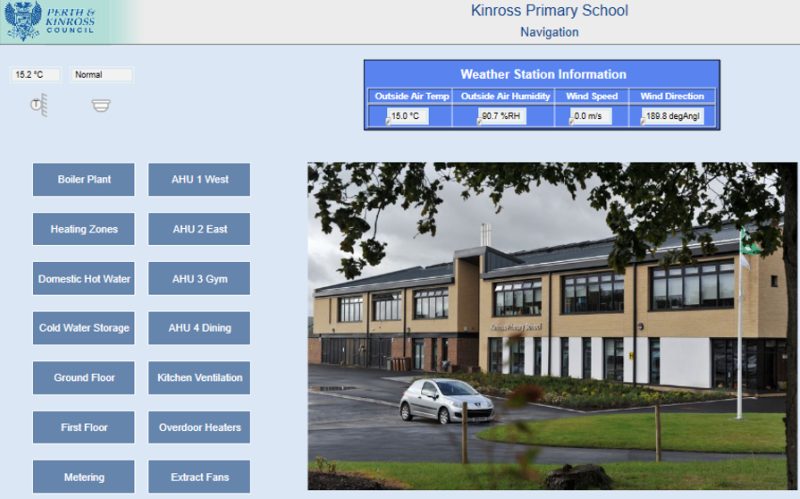
Crieff Area Officer Co-location with Police Scotland
Police Scotland have moved out of their former station King Street, Crieff into vacant space within Perth & Kinross Council’s Crieff Area Office, James Square, Crieff.
Police Scotland carried internal works to bring the areas they are occupying up to their standards. The co-locating with public service partners in shared facilities not only allows greater collaborative working it also contributes to reducing our carbon footprint and the long-term costs of maintaining public sector buildings.
The co-location with Police Scotland will allow for closer working between our existing Housing Services and Health and Social Care partnership staff. This will not only strengthen existing partnerships and identify areas for shared improvement but will also allow greater focus on prevention and early intervention.

Eco Schools Scheme
Eco Schools Scotland have awarded Coupar Angus Primary School their Fifth Green Flag in recognition of their ongoing commitment to the environment. They commented that they “commend the work that Coupar Angus Primary School has been doing over the last few years. It was a joy to read how the pupils and the local community have been getting involved with their Eco-Schools Journey.” The school has accomplished the following achievements and several children received their John Muir Award during the course of these projects:
- Planting of trees and identification of wildlife through the Butterybank Community Woodland Project and local Burn Project
- Creation of an Interpretation Board which was unveiled at the opening of the Woodland
- An activity day arranged in the woodland for the whole school and families to enjoy and learn about the woodland
The school has focussed on re-using and recycling by forming a Uniform Bank where families can hand in school uniform in good condition that is no longer used. Also, crisp bags were collected to raise money for the Scottish Air Ambulance and reduce litter, some of the crisp bags were transformed by the Eco Club into Aprons and Purses


